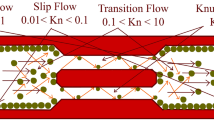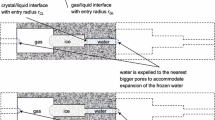Abstract
A constitutive relationship is developed to characterize the flow of high velocity, compressible, heated gases through concrete. This relationship equates a nondimensional flow parameter with pressure and temperature ratios across the medium. The key premise is that the resistance to flow through a porous medium can be modeled with friction coefficients analogous to the method used for simpler geometries. The utility of a porous media compressible flow parameter is appraised by comparing it with the Forchheimer equation modified for an ideal gas. There is little difference in adiabatic flow rates predicted by the two relationships. The Forchheimer equation does not account for the effects of heating. The flow parameter predicts mass flows through a slab of concrete to decrease by nearly 50% when this medium is heated from 25 to 350‡C.
Similar content being viewed by others
References
U.S. Naval Civil Engineering Laboratory, Technical Report: Moisture induced pressures in concrete airfield pavements, by C. A. Kodres. Port Hueneme, California, to be published.
Sahota, M. S. and Pagni, P. J., Heat and mass transfer in porous media subject to fires,Internat. J. Heat Mass Transfer 22(7) (1979), 1069–1081.
Bazant, Z. P. and Thonguthal, W., Pore pressure in heated concrete walls: theoretical prediction,Magazine of Concrete Res. 32(107) (1979), 67–76.
Huang, C. L. D. and Ahmed, G. N., Influence of slab thickness on responses of concrete walls under fire,Numerical Heat Transfer, Part A 19 (1991), 43–64.
Doughty, C. and Pruess, K., A similarity solution for two phase fluid and heat flow near high-level nuclear waste packages emplaced in porous media,Internat. J. Heat and Mass Transfer 33(6) (1990), 1205–1222.
Ahmed, N. and Sunada, D. K., Nonlinear flow in porous media,J. Hydraulics Div. Proc. Amer. Soc. Civil Eng. 95 [HY6] (1969), 1847–1857.
Firoozabadi, A. and Katz, D. L., An analysis of high-velocity gas flow through porous media,J. Petrol. Technol. (February 1979), 211–216.
Noman, R. and Archer, J. S., High-velocity flow in liquid saturated porous media and its visualization,J. Canad. Petrol. Technol. 27(3) (1988), 64–69.
Geertsma, J., Estimating the coefficient of inertial resistance in fluid flow through porous media,Soc. Petrol. Eng. J. (October 1974), 445–450.
Bear, J.,Dynamics of Fluids in Porous Media, Elsevier, New York, 1972, pp. 125–127.
Wright, D. E., Nonlinear flow through granular media,J. Hydraulics Div. Proc. Amer. Soc. Civil Eng. 94 [HY4] (1968), 581–872.
Hassanizadeh, S. M. and Gray, W. G., High Velocity flow in porous media,Transport in Porous Media 2 (1987), 521–531.
Temeng, K. O., Effects of high pressure gradients on the flow of real gases through porous media, PhD Dissertation, Stanford University, Stanford, CA, August 1988.
Fancher, G. H. and Lewis, J. A., Flow of simple fluids through porous materials,Industr. Eng. Chem. 25(10) (1933), 1139–1147.
Green, L. and Duwez, P., Fluid flow through porous metals,J. Appl. Mech. 18 (1951), 39–45.
Cornell, D. and Katz, D. L., Flow of gases through consolidated porous media,Industr. Eng. Chem. 45(10) (1953), 2145–2152.
Cornell, D., Flow of gases through consolidated porous media, PhD Dissertation, University of Michigan, Ann Arbor, 1952.
McVay, M. C. and Rish, J. W., Flow of nitrogen and superheated steam through cement mortar, submitted for publication to theJ. Thermophys. Heat Transfer.
Zucrow, M. L. and Hoffman, J. D.,Gas Dynamics, vol. I, Wiley, New York, 1976, Appendix C.
Shapiro, A. H.,The Dynamics and Thermodynamics of Compressible Fluid Flow, vol. I, Ronald Press, New York, 1953, Section 4.4.
Author information
Authors and Affiliations
Rights and permissions
About this article
Cite this article
Kodres, C.A. Flow parameter approach to modeling the flow of heated gases through high resistance porous media. Transp Porous Med 15, 229–249 (1994). https://doi.org/10.1007/BF00613280
Received:
Revised:
Issue Date:
DOI: https://doi.org/10.1007/BF00613280




